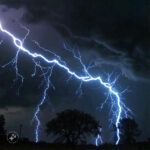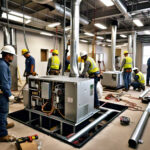The electricity:
It is a type of good energy. We use it for many purposes.We have many locations is In refrigeration air conditioning it drives motors and produces heat or light.Used to do less.There is a fundamental difference between electricity and electronics. One of electronic physics.Branches in which electrons flow in vacuum tubes, gases, and semiconductors.The effects are seen. While electricity is also a branch of physics in which only,The outward process is seen from its effects.Every substance in this world is made up of small particles. to them called molecules. These molecules would survive under normal conditions and retain their properties have If these molecules are broken down in some way, they become even smaller.Breaks down into parts that can only be seen with a microscope. This particle is called an atom is if this atom is seen through a microscope, it has more tiny particles.
These are the following:
- 1- Proton
- 2- Neutron
- 3- Electron
Protons and neutrons are packed together in the center of an atom. This part Stays still. It is called New Kiss Hivan. while the electrons around the same nucleus Circling in circles by varying amounts. If these electrons are somehow transferred to them. If it is removed by the attractive force of the nucleus and transferred to another atom.It is called an electrical bar and if these electrons are charged continuously, it is called electricity are Electricity: The continuous flow of electrons is called electricity.
Types of Electricity KINDS OF ELECTRICITY
KINDS OF ELECTRICITY
AC and DC 1- ALTERNATING CURRENT(AC) 2 Direct current (DC)
Alternating Current: Also called AC supply. It is the supply that, The current in the circuit changes its direction and this change in one second happens fifty times. A change is called a cycle. Which means this it changes from positive to negative and from negative to positive fifty times in one second. This the conversion is 50 cycles per second.AC supply is used frequently nowadays. This high voltage circuit, I use It was used in domestic wiring and commercial factoriesis its pointer (~) is Direct Current: Also called DC supply. This is the supply. Which it goes straight through the circuit and is used only in low voltage circuits is its pointer (_) is.
Electrical Materials
- -1 CONDUCTOR
- -2 RESISTOR
- -3 INSULATOR
Insulator Conductor: It is also called conductor. Materials that conduct electricity easily, Let it pass are called conductors. Actually in the atoms of these objects Electrons can be easily shed. Because they have more free electrons are For example, silver, copper, brass know etc.Resistor: It is called a semi-conductor. Materials that obstruct the flow of electricity. The insert is called a semiconductor or resistor. Actually the electrons of these objects cannot be shed easily because they have less number of free electrons. For example Chromium, Graphite, Silicon etc.Insulator: It is also called non-insulator. Materials of which Bailey does not at all Conductors are called non-conductors or insulators.In reality, the electrons of these objects are not separated from their atoms can because they do not have free electrons at all. Vacuum dried wood, rubber plastic Bakelite mica wax etc. And no moisture has any chemical effect.
Electrical terms
TERMS OF ELECTRICITY
- 1 VOLTAGE
- 2 Current
- 3 POWER
- 4 Resistance
Voltage: It is also called electrical pressure. This is the force that the electrons in the wires flows. It is written as (V). Its unit is volt. Also to Volt Write from (V).
Current: It is called electric current. Current is the constant flow rate of electrons say. It is written as (A). Its unit is Emir. Which is written as (A).
Power: It is also called power. So does the rate of work in physics Power is called but the product of voltage and current in electricity is called power.It is written as (P). Its unit is also the watt. Which is written by (W).
While 746 watts = one horsepower and the formula for power is P = V x I.That is, power = volts x current Example:
A refrigerator draws 115 m current at 220 volts.Find its power.
V = 220V, I = 1.5A,
P = ? .
P = V x I = 220 x 1.5 Watts = Volts x Curren
P = P = 220×15/10
P = 22 x 15
P = 330 Watt (ANSWER)Resistance
Resistance: It is also called resistance. This is a feature that anyone found in the resistor. i.e. the property of a material as a barrier to flow Called resistance or rise mits. It is written as R. Its unit is Ohm.The symbol for Ohm is written as Ω.
Is Water Resistance Factor: The resistance of a wire depends on the following factors.
- 1 wire length
- 2 wire thickness.
- 3 Wire temperature.
- 4 Wire material.
Length of wire: This means that if the diameter of the wire is less, so is the resistance is less and the longer the length, the greater the resistance.
Wire thickness: This means that if the wire is thinner, the resistance is high erand if the wire is thick, the resistance is less.
Wire Temperature: This refers to the resistance if the wire is cold, If the wire is hot, the resistance is high.
Wire Material: This means that if the wire material is good, the resistance is low. It happens, Resistance is high if the material is not good.
OHM’S LAW
This law was created by a scientist, George Sine Adams, in which he, The relationship between voltage current and resistance is found as follows. This is the law Named as-1- If the voltage in a circuit is kept constant, by reducing the resistance Current increases and increasing resistance decreases current. That is, the current and Resistances are inversely proportional to each other.
I a 1/RI =Kx1/R= 1K =I = 1/R………..(i)2-
If the resistance in a circuit is made constant, the current by increasing the voltage also increases and as the voltage decreases the current also decreases. That is, current and voltage are directly proportional to each other.
I & VI = K x VK = 1 I = (ii) Equation No. (i) and Equation No. (ii) By combining Volts = Current x Resistance Resistance = defeat
I=RV=IXR In this 1 = current or electric current 7 = voltage or electrical pressure= RR = ½Resistance or resistance.








